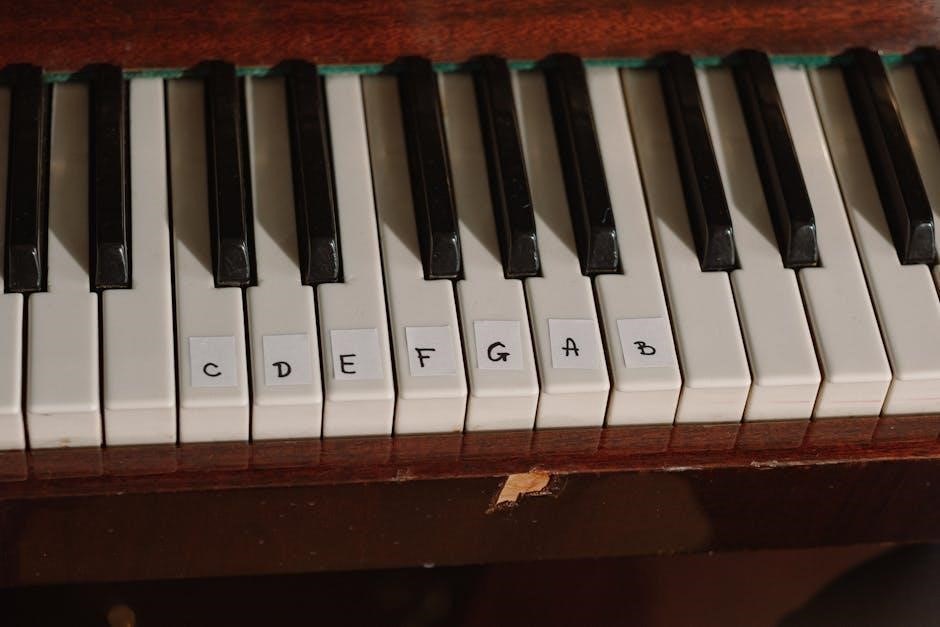Minor scales are essential in piano music‚ offering a somber‚ introspective sound․ They include natural‚ harmonic‚ and melodic forms‚ each with unique intervals and applications in composition and improvisation․ Resources like PDF files and sheet music provide fingerings and notations for practice‚ helping pianists master these scales effectively․
1․1․ Overview of Natural‚ Harmonic‚ and Melodic Minor Scales
The natural minor scale‚ also known as the Aeolian mode‚ features a distinct sequence of whole and half steps․ The harmonic minor scale raises the 7th scale degree‚ creating a leading tone‚ while the melodic minor scale raises the 6th and 7th degrees when ascending‚ offering a brighter sound․ These scales are enharmonically equivalent in certain keys‚ such as D minor and Eb minor․ They are widely used in composition and improvisation‚ providing rich harmonic possibilities across various musical genres․
1․2․ Importance of Minor Scales in Piano Music
Minor scales are fundamental to piano music‚ providing emotional depth and complexity․ They are extensively used in composition and improvisation‚ allowing pianists to express a wide range of emotions․ The natural‚ harmonic‚ and melodic minor scales each offer unique harmonic possibilities‚ enhancing musical expression․ Resources like PDFs and sheet music are invaluable for mastering these scales‚ as they provide detailed fingerings and notations․ Understanding minor scales is crucial for pianists‚ enabling them to explore various musical genres and create compelling performances․
1․3․ Types of Minor Scales: Natural‚ Harmonic‚ and Melodic
There are three primary types of minor scales: natural‚ harmonic‚ and melodic․ The natural minor scale follows a specific interval pattern‚ while the harmonic minor scale features a raised 7th degree․ The melodic minor scale has distinct ascending and descending forms‚ with alterations to the 6th and 7th degrees when ascending․ Each type serves different musical purposes‚ from composition to improvisation․ Resources like PDF files and sheet music provide clear notations and fingerings for mastering these scales on the piano․

Construction of Minor Scales
Minor scales are built using specific interval patterns․ The natural minor scale forms the basis‚ while harmonic and melodic minors introduce alterations like raised 7ths for musical expression․
2․1․ Understanding the Intervals in Minor Scales
The natural minor scale follows the interval pattern W-H-W-W-W-W-H (whole‚ half‚ whole‚ whole‚ whole‚ half steps)․ This structure differs from major scales‚ creating a distinct melodic and harmonic identity․ Harmonic and melodic minor scales introduce variations‚ such as the raised 7th scale degree in harmonic minors‚ enhancing their emotional depth․ These interval patterns are fundamental to understanding how minor scales function in music composition and improvisation․
2․2․ How Minor Scales Differ from Major Scales
Minor scales differ from major scales primarily in their interval structure and emotional connotation․ The natural minor scale has a minor third‚ minor sixth‚ and minor seventh‚ creating a somber tone‚ unlike the major scale’s bright quality․ Additionally‚ harmonic and melodic minor scales introduce altered intervals‚ such as the raised 7th scale degree‚ which further distinguish them from major scales․ These differences contribute to the unique sound and versatility of minor scales in various musical genres and compositions․

Natural Minor Scale
The natural minor scale‚ also known as the Aeolian mode‚ follows the interval pattern: W-H-W-W-H-W-W․ It is the most commonly used minor scale in music‚ providing a somber‚ introspective sound and serving as the foundation for harmonic and melodic minor scales․
3․1․ The Structure of the Natural Minor Scale
The natural minor scale‚ or Aeolian mode‚ consists of the interval sequence: whole‚ half‚ whole‚ whole‚ half‚ whole‚ whole․ This structure creates a distinct‚ melancholic sound․ Each scale is built from a tonic note‚ with specific whole and half steps‚ forming seven notes before returning to the octave․ For example‚ the A natural minor scale includes the notes A‚ B‚ C‚ D‚ E‚ F‚ G‚ A․ This pattern is consistent across all natural minor scales‚ making it a fundamental element in music theory and piano study․
3․2․ Examples of Natural Minor Scales on the Piano
Examples of natural minor scales on the piano include A minor‚ C minor‚ and E minor․ The A natural minor scale consists of the notes A‚ B‚ C‚ D‚ E‚ F‚ G‚ A‚ with fingerings provided for both hands․ Similarly‚ the C natural minor scale includes C‚ D‚ E‚ F‚ G‚ A‚ B‚ C․ These scales are often included in PDF resources‚ such as those from pianostreet․com‚ offering clear notations and fingerings for practice․ Mastering these examples helps pianists develop familiarity with the natural minor scale structure and its application in various musical contexts․

Harmonic Minor Scale
The harmonic minor scale features a raised 7th scale degree‚ creating a distinct sound․ It is often used in composition to add tension and emotional depth․ Resources like PianoLessons․com offer PDF guides for practicing harmonic minor scales on the piano‚ providing clear notations and fingerings for musicians․
4․1․ The Role of the Raised 7th Scale Degree
The raised 7th scale degree in the harmonic minor scale creates a leading tone‚ enhancing harmonic tension․ This alteration facilitates smooth modulations and adds emotional depth to compositions․ It is particularly useful in creating dramatic effects and preparing for key changes․ Resources like PianoLessons․com provide detailed PDF guides‚ showcasing how this raised interval impacts chord progressions and musical structure․ Understanding this concept is crucial for pianists aiming to master harmonic minor scales effectively․
4․2․ Examples of Harmonic Minor Scales on the Piano
Practicing harmonic minor scales on the piano enhances musical understanding․ For instance‚ the D harmonic minor scale includes notes D‚ E‚ F‚ G‚ A‚ B♭‚ C#(raised 7th)‚ and D․ Similarly‚ the A harmonic minor scale features A‚ B‚ C‚ D‚ E‚ F‚ G#‚ and A․ These scales are often used in compositions for their unique emotional impact․ Resources like PDF files from pianostreet․com and PianoLessons․com provide clear notations and fingerings‚ making it easier for pianists to learn and master these scales effectively․

Melodic Minor Scale
The melodic minor scale is unique‚ using different notes for ascending and descending․ It is crucial in composition and improvisation‚ offering rich harmonic possibilities for pianists․


5․1․ The Unique Characteristics of the Melodic Minor Scale
The melodic minor scale has distinct features‚ primarily in its ascending form․ It raises the 6th and 7th scale degrees‚ creating a leading tone effect․ This modification enhances harmonic richness and provides a bright‚ uplifting quality compared to natural and harmonic minors․ When descending‚ the scale typically reverts to the natural minor form‚ smoothing the transition․ This dual nature makes the melodic minor versatile in both composition and improvisation‚ allowing for complex emotional expressions in music․
5․2․ Examples of Melodic Minor Scales on the Piano
The melodic minor scale is demonstrated through various keys on the piano․ For instance‚ the A melodic minor scale ascends as A‚ B‚ C‚ D‚ E‚ F#‚ G#‚ and descends as A‚ G‚ F‚ E‚ D‚ C‚ B‚ A․ This pattern applies to all keys‚ with raised 6th and 7th degrees in ascending passages․ PDF resources provide fingering charts and sheet music for practice‚ such as C melodic minor and D melodic minor‚ aiding pianists in mastering these scales effectively for composition and performance․

Practical Applications of Minor Scales in Music
Minor scales are widely used in composition and improvisation‚ adding emotional depth to music․ They are fundamental in various genres‚ from classical to jazz․ Resources like PDFs and sheet music aid pianists in mastering these scales for practical performance and creative expression․
6․1․ Using Minor Scales in Composition and Improvisation
Minor scales are invaluable in composition and improvisation‚ providing a rich foundation for creating emotive melodies․ Composers often use natural minor for somber themes‚ harmonic minor for tension‚ and melodic minor for lyrical passages․ Pianists can incorporate these scales into improvisation by experimenting with their intervals and modes․ PDF resources offer fingering guides and scale diagrams‚ aiding musicians in mastering these techniques and enhancing their expressive capabilities in various musical contexts․
6․2․ The Role of Minor Scales in Various Musical Genres
Minor scales are integral to diverse musical genres‚ from classical to jazz and pop․ Classical music often employs harmonic and melodic minors for dramatic contrast‚ while jazz uses these scales for complex harmonies․ In pop‚ natural minors evoke emotional depth․ Each genre leverages the unique qualities of minor scales to create distinct moods․ Resources like PDF files provide detailed notations‚ helping musicians adapt these scales to their specific stylistic needs‚ ensuring versatility and emotional resonance across different musical traditions and contemporary compositions․

Resources for Learning Minor Scales
PianoLessons․com and pianostreet․com offer comprehensive PDFs and sheet music for natural‚ harmonic‚ and melodic minor scales․ These resources include fingerings and notations‚ aiding effective practice and mastery․
7․1․ Recommended PDF Files and Sheet Music for Minor Scales
Recommended PDFs and sheet music for minor scales are available on websites like PianoLessons․com and pianostreet․com․ These resources provide detailed notations‚ fingerings‚ and exercises for natural‚ harmonic‚ and melodic minor scales․ Sheet music often includes both left-hand (LH) and right-hand (RH) fingerings‚ ensuring comprehensive practice․ Additionally‚ some PDFs feature scales arranged in two octaves‚ enhancing mastery․ These materials are ideal for pianists seeking to improve their understanding and performance of minor scales in various musical contexts․